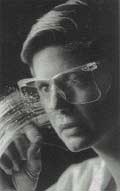Faster links
 the information superhighway has brought with it the need for fast and reliable communication channels. The old telephone cables cannot supply the bandwidth required for applications like multimedia or video conferencing. Optical fibres have truly revolutionised communications in the last few years.
the information superhighway has brought with it the need for fast and reliable communication channels. The old telephone cables cannot supply the bandwidth required for applications like multimedia or video conferencing. Optical fibres have truly revolutionised communications in the last few years.
But there are potholes on this information highway. Though the optical fibres use pulses of light and are very fast, the switches which form the nodes of any network are electronic. They slow down the data speeds. One way of getting around this problem is to introduce optical switches, but these have not been successful as yet. Seth Marder and his team from the California Institute of Technology, Pasadena, usa , may bring the vision of optical switches much closer to reality ( Science , Vol 276, No 5316).
Marder and his team have developed a new polymer that could help in making optical switches that speed up the communication channels. The new polymer has enhanced optical properties of a very special kind. Almost all optical materials display an unusual effect called a third order nonlinear optical effect ( nlo ).
This is a temporary effect in which the electric field of an incoming light beam generates a secondary field in the material. This secondary field interacts with a pair of photons (second order effect), or even a trio of photons (third order effect).
This interaction is very weak and leads to the production of harmonics over and above the frequency of the incoming light. These harmonics can then be used to alter the properties such as the refractive index of the material. If this is achieved, the material can be used to switch the light beam from one fibre to another.
The material used by the group is based on beta-carotene, a source of vitamin a available in carrots. The original molecule has a long chain of carbon atoms which are capped on either ends by ring shaped groups. The researchers replaced the ring shaped groups by others which fundamentally altered the properties of the material. The altered material was then added to a polymer known as methyl methacrylate and made into films. The films were seen to produce an nlo effect 35 times more than the original molecule.
However, the polymer developed by the researchers is unsuitable for commercial applications. The reason being it is notoriously unstable under heat and light. But the scientists say the same phenomenon can be replicated in more robust materials which can then be used for commercial optical switches.
Related Content
- Tourism and climate change stocktake 2023
- Overlooked: examining the impact of disasters and climate shocks on poverty in the Europe and Central Asia Region
- EV city casebook and policy guide 2021
- Forest bioenergy and Canada’s Clean Fuels Standard: Potential carbon impacts
- Transformation and sources of growth in Southeast Asian agriculture
- Earth system commitments due to delayed mitigation
